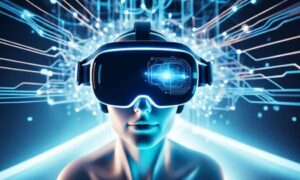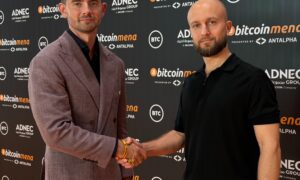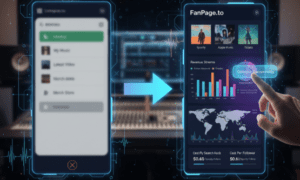Michael Cherkashin is a multidisciplinary designer known for his innovative approach to product and brand design. His work showcases how design can drive innovation while creating exceptional user experiences. A lifelong learner and visionary, Michael is constantly pushing boundaries, redefining the role of design in a fast-evolving, tech-driven world.
Michael, your career has been a remarkable journey. Let’s start at the beginning—what first drew you to the world of design, and how did your early experiences shape the designer you are today?
I’ve been drawn to visual arts since I was a little kid—always sketching, sculpting, or creating something. When I got my first computer at around age 11, it came preinstalled with Photoshop from the previous owner. I was hooked right away and started experimenting with everything I could. That led to my first summer job at the age of 15 at a local print house. There, I learned the technical side of things, like color theory and typography.
Since I started early—well before college—I read every book I could find about branding, advertising, graphic design, and color theory. A couple of my favorites are The 22 Immutable Laws of Branding by Al Ries and Laura Ries, and Ogilvy on Advertising. These classics teach you to think intentionally about the details and to always do your research.
These principles are just as relevant in today’s technological world. Modern design, especially UI, is less about the visual arts and more about maximizing business outcomes—where every little detail is intentional. Understanding this way of thinking at 15 gave me a real head start in my career.
From those beginnings, you’ve received widespread recognition for your contributions. Which achievements are you most proud of, and how have they shaped your perspective on the impact of design?
Being featured in Communication Arts magazine was a huge honor for me. It’s one of the oldest and most respected design publications, established in 1959. Fun fact—it was also the first magazine in the U.S. printed using offset lithography. Having started my career in a print house working with those old machines, I’ve always been fascinated by how design and technology evolve together.
This experience reinforced something I’ve come to believe: design today is about balancing existing best practices with innovation. In user experience and product design, for example, users are often accustomed to doing things a certain way. If you deviate too much from those patterns, you create unnecessary friction. But at the same time, technology is constantly evolving, allowing us to make interactions more efficient and enjoyable. It’s a delicate balance.
You’ve collaborated with large enterprises and tech startups. How do you ensure your designs align with their goals for growth and scalability?
Successful product design is ultimately about maximizing business outcomes. While there are many success metrics—like daily active users, retention rates, satisfaction scores, or conversion rates—I believe the main goal for any company should be to build an amazing product that people love.
If your product truly improves users’ lives, achieving growth or hitting key metrics becomes much less of a challenge. If I could offer one piece of advice to designers, it would be to focus on creating the best version of the product possible. Everything else follows from there.
Innovation is a cornerstone of your expertise. Two projects of yours that come to mind are the Tesla Model 3 infotainment system and a smart home OS. What principles or methodologies do you adhere to, and why are they important?
Both of these projects fall under the HMI category or Human-Machine Interface design, which deals with how users interact with devices like cars, smart homes, or factory machinery for example. These interfaces are different from more mature platforms, like phones or desktops, where UX practices and solutions are already well-established. I personally believe that with HMI design, there’s more room for innovation.
It’s crucial to understand where, when, how, and why a user interacts with the device. For example, the user experience for a TV is entirely different from that of a smartwatch. On one hand, a smartwatch is often used on the go, requiring quick interactions, on the other, a TV is used in a more immersive, intentional setting, so it is crucial to create user personas and place them in exact circumstances they use the product.
Another important consideration is deciding when to prioritize familiarity versus efficiency. For example, with frequently used products like a phone OS or a car interface, you can introduce less intuitive but more efficient interactions—like swiping up to unlock an iPhone. Initially, it might not feel natural, but it becomes second nature with repeated use. Conversely, for something like a DMV website, which users interact with rarely, the experience should be straightforward and highly familiar, even if it’s not the most efficient.
Ultimately, the key is to stay intentional, do your research, validate your assumptions, and avoid making decisions based on aesthetics or trends alone. Every choice should have a reason behind it.
Many tech startups struggle with building a strong brand early on. What advice would you give founders looking to create a brand that stands out in crowded markets?
First, it’s important to understand what a brand really is. Many people think it’s just a set of visual or verbal guidelines to ensure consistency. On a deeper level, a brand is the image of your company or product that exists in people’s minds and hearts.
Before diving into the tangible aspects—like visuals or tone of voice—I encourage founders to focus on fundamentals: why their business exists, its purpose, its values, and its unique personality. Once these are clear, they can be translated into the visual and other tangible identity elements
I’d also advise founders to stay authentic. Don’t try to position your company or product as something it’s not. Instead, find the essence that’s true to you and your business—something that will genuinely resonate with your audience.
Many designers look up to you as a trailblazer. What advice would you offer to aspiring designers or founders hoping to succeed and stay ahead of the curve?
Never stop learning and experimenting. One of the biggest mistakes beginner designers make is assuming that if a big tech company does something, it must apply universally, or that following a trend will automatically lead to success. It’s crucial to understand the reasoning behind a design decision—why it was made, its purpose, and its results. Only then can you apply those principles strategically.
For visionary founders, it’s crucial to strike a balance between user feedback and your own vision. It’s easy to fall into one of two extremes: either believing, “I have the vision, and users just don’t understand it yet,” or trying to implement every suggestion users make. Neither approach leads to the best outcomes. Instead, focus on understanding users’ pain points and refining solutions that align with your vision. Consider how each change will impact the overall product, ensuring it stays true to your goals while addressing user needs effectively.
Finally, Michael, as someone who’s shaped the way design influences technology and business, what’s your vision for the future? Are there any big trends or shifts you’re watching closely?
I’d say design influences technology just as much as technology influences design. Often, when I propose a new interaction or idea, it sparks engineers’ creativity, and they find innovative ways to implement it. But just as often, new technologies emerge that give designers incredible new tools to work with.
For instance, it’s now easier than ever to create engaging, game-like interfaces with 3D elements or interactivity that wasn’t possible before. AI, of course, is already opening up new doors for creativity and productivity—and this shift is going to be much more transformative than most people realize.
Looking ahead, I think human-machine interaction will rely less on graphical interfaces and become more embedded and intuitive. We might soon interact with technology using thoughts instead of manual input like typing or tapping. That would be my prediction for the next five to ten years.































